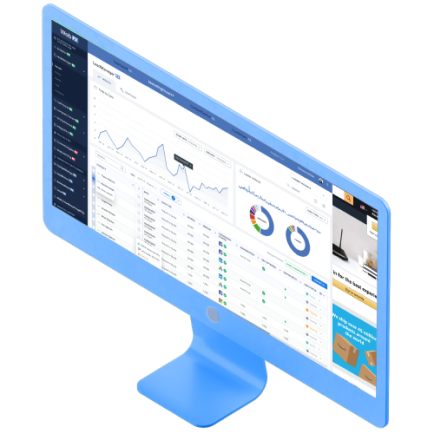-
 Published: May 31, 2023
Published: May 31, 2023
-
 6 min. read
6 min. read
-
 Matthew Gibbons
Matthew Gibbons Senior Data & Tech Writer
Senior Data & Tech Writer
- Matthew is a marketing expert focusing on the SEO & martech spaces. He has written over 500 marketing guides and video scripts for the WebFX YouTube channel. When he’s not striving to put out some fresh blog posts and articles, he’s usually fueling his Tolkien obsession or working on miscellaneous creative projects.
What is data segmentation? Data segmentation is the process of dividing up your company data into different groups based on similar characteristics.
We made a video explaining the concept (in addition to the blog content below)!
When I was a kid, I loved Lego. I accumulated tons of sets, adding up to thousands of pieces. Over the years, all those pieces became mixed together in huge Rubbermaid tubs. Unfortunately, that made it incredibly hard to build specific sets — I’d have to spend hours searching for the right pieces.
Believe it or not, the same thing can happen with your company’s marketing and sales data — that is, if you’re not strategic with your data management. Throwing all your data together in one big bucket isn’t going to benefit you very much.
So, what do you do? The same thing I eventually did with all that Lego — you sort it out into specific groups. That process is called data segmentation.
But what is data segmentation, and why is it important? Keep reading to find out. Then subscribe to Revenue Weekly, our email newsletter, for more digital marketing tips from the experts!
Join 200K smart marketers for the hottest marketing news and insights in your inbox. “*” indicates required fieldsDon’t miss our Marketing Manager Insider emails!
Inline Subscription Form


What is data segmentation?
Data segmentation is the process of sorting your company data — particularly your marketing, sales, and customer data — into different groups. These groups are based on shared characteristics — for example, if you’re sorting customer data, you might divide it up based on location.
You then perform analytics and reoptimization separately for each group.
Why is it important to segment data?
Not all your marketing campaigns are the same, and neither are your leads or customers. So, if you compile the data from all those campaigns and customers into one big group and then try to use that single dataset to optimize your marketing, you won’t have much luck.
Data segmentation allows you divide your data into smaller groups that can give you more specific, relevant insights. For example, let’s say around 25% of your customers live in Memphis, Tennessee. So, you try out an ad campaign that promotes your products as “the best in Memphis.”
If you group all your audience data together and then analyze it that way, it will make the campaign seem ineffective. Less than 25% of your audience is responding well to that ad campaign — it must not be very good!
But if you segment your audience data, you’ll see that while of course that campaign doesn’t work well for people outside of Memphis, for that 25% of your audience that lives in Memphis, it’s incredibly effective!
That’s just one example of how data segmentation can be useful. Overall, segmenting data helps you reach your ideal customer profiles (ICPs), making your data more actionable.
4 tips for segmenting data
Now that we’ve established what data segmentation is and why it matters, let’s cover some helpful tips for segmenting data. Here are four techniques to try:
- Try different data segmentation methods
- Clean and enrich your data
- Prioritize the best segments to target
- Regularly analyze your customer segmentation
Keep reading to learn more about each one!
1. Try different data segmentation methods
Firstly, you should try out more than one type of data segmentation. In the last section, I used location as an example data point. But you wouldn’t want to segment based only on location. You should also factor in other types of data, including:
- Age
- Gender
- Business size
- Behavioral data
Of course, which data types you look at depends on whom you’re selling to — business size is only relevant if you’re a business-to-business (B2B) company, for instance. Still, it’s useful to try out different ways of dividing your data, so you can account for multiple factors.
2. Clean and enrich your data
Segmenting your data will be useless to you if the data itself is low in quality. You should aim for the highest-quality data possible.
There are two ways to do that. The first is to clean your data. That means going through all your datasets and removing any errors, inconsistencies, or redundancies you find.
The other way to improve your data quality is to use data enrichment. Data enrichment is where you pull in additional first- and third-party data to flesh out the existing data that you have.
By cleaning and enriching your data before you segment it, you’ll be able to get richer insights from it down the road.
3. Prioritize the best segments to target
Once you segment data — specifically your customer and audience data — take some time to identify the best segments to target. Not all customer segments are equally useful to you.
For example, you might sell to businesses in the automotive, aerospace, and HVAC industries. So, you divide your audience up into three different segments, one for each of those industries. But then, once you analyze each segment, you might find that 85% of your revenue comes from the automotive industry alone.
In that case, you’ll know to prioritize your marketing and sales efforts to automotive businesses. That doesn’t mean you neglect businesses in the aerospace or HVAC industries, it just means they don’t receive the same priority as the automotive industry.
4. Regularly analyze your customer segmentation
Finally, keep in mind that customer segmentation doesn’t end after the first time you segment your audience. Your audience might change and shift over time, especially if you develop new products or services.
To account for that, you should regularly analyze your customer segmentation strategy and adjust when needed. Even if you don’t ever have to create entirely new segments, you might still find that you want to adjust the exact criteria for certain existing segments.
Doing this will ensure that your data segmentation is always up-to-date, and therefore equipped to give you the best possible results.
How WebFX tools can help with data segmentation
To succeed with data segmentation, you need the right tools. Fortunately, WebFX offers just the tools you need: RevenueCloudFX — our marketing software — and Nutshell, our customer relationship management (CRM) platform. When you get RevenueCloudFX, you get free seats in Nutshell along with it.
With the killer combo of RevenueCloudFX and Nutshell, you can easily segment your data and your audience into different groups. Better yet, you can automate the process, sending new leads and customers to the right segments the moment they enter the platform.
After segmenting your data, you can use RevenueCloudFX and Nutshell to analyze it, uncovering insights about your campaigns and your audience. You can then use our tools to target leads based on those insights, vastly improving your marketing efforts.
One platform tracking countless metrics and driving stellar results.Meet RevenueCloudFX:


WebFX will optimize your marketing efforts
When you partner with WebFX, you will have access to marketing and data segmentation tools and the option of using our digital marketing services.
Our team can help you segment your data strategically and target your audience with the ideal campaigns, driving revenue in the long run.
Interested in partnering with WebFX? Just call us at 888-601-5359 or contact us online today to get started!
-
 Matthew is a marketing expert focusing on the SEO & martech spaces. He has written over 500 marketing guides and video scripts for the WebFX YouTube channel. When he’s not striving to put out some fresh blog posts and articles, he’s usually fueling his Tolkien obsession or working on miscellaneous creative projects.
Matthew is a marketing expert focusing on the SEO & martech spaces. He has written over 500 marketing guides and video scripts for the WebFX YouTube channel. When he’s not striving to put out some fresh blog posts and articles, he’s usually fueling his Tolkien obsession or working on miscellaneous creative projects. -

WebFX is a full-service marketing agency with 1,100+ client reviews and a 4.9-star rating on Clutch! Find out how our expert team and revenue-accelerating tech can drive results for you! Learn more
Try our free Marketing Calculator
Craft a tailored online marketing strategy! Utilize our free Internet marketing calculator for a custom plan based on your location, reach, timeframe, and budget.
Plan Your Marketing Budget
Table of Contents
- What is data segmentation?
- Why is it important to segment data?
- 4 tips for segmenting data
- 1. Try different data segmentation methods
- 2. Clean and enrich your data
- 3. Prioritize the best segments to target
- 4. Regularly analyze your customer segmentation
- How WebFX tools can help with data segmentation
- WebFX will optimize your marketing efforts

Proven Marketing Strategies

Proven Marketing Strategies
Try our free Marketing Calculator
Craft a tailored online marketing strategy! Utilize our free Internet marketing calculator for a custom plan based on your location, reach, timeframe, and budget.
Plan Your Marketing Budget
What to read next





